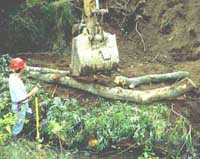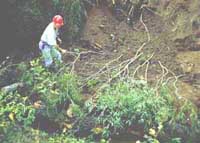Live cribwall with cuttings protruding from between the timbers of the crib frame.
Live Cribwalls < previous | 1 | 2 | 3 | 4 | 5 | 6 | 7 | 8 |
A live cribwall is a frame
built with untreated timbers, and filled with soil and live cuttings. Once
completed, this structure acts as a retaining wall. The timbers provide immediate
protection and stability for the structure. Over time their importance gradually
decreases as they decompose. Meanwhile, the live cuttings grow, and the resulting
root mass binds together the internal fill and the adjacent undisturbed soil.
 Cross
section of a live cribwall, showing crib frame, excavation and live cuttings.
The structure itself should not be built too high (maximum 2 meters), however
can be strung into a linear series at the toe of a slope, or along a streambank.
Cross
section of a live cribwall, showing crib frame, excavation and live cuttings.
The structure itself should not be built too high (maximum 2 meters), however
can be strung into a linear series at the toe of a slope, or along a streambank.
Like live soft gabions, live cribwalls are built at the toe of a slope. An important difference however is that cribwalls are built to a maximum of about 2 meters, while soft gabions can go much higher up the slope. None the less, cribwalls are a major undertaking, most easily built using heavy machinery for excavation. I can see myself tackling a project with cribwalls more easily than soft gabions, given their smaller vertical size. Regardless, due to the required excavation, cribwall construction can cause considerable site disturbance. However when used where appropriate, live cribwalls are an effective means of stabilizing steep slopes, or highly eroded riverbanks.
Cribwalls are also similar to spilling walls in that they can be built within stream channels along the banks (see image above right). However, given their size, significant excavation is required so that they can be set far enough back into the bank to avoid reducing the volume of the channel. Otherwise the capacity of the watercourse to handle stormflow could be reduced, making floods worse.
Ease of access to the site is an important consideration both in terms of bringing in machinery, and timbers for the crib. The volume of soil to be moved, and quantities of timber needed make such a project extremely difficult without mechanical assistance on a remote site. At a minimum in such a place it would only be practical where significant timber was available nearby without creating prohibitive amounts of disturbance cutting it ( and that still would not solve the excavation issue).
< previous | 1 | 2 | 3 | 4 | 5 | 6 | 7 | 8 |




